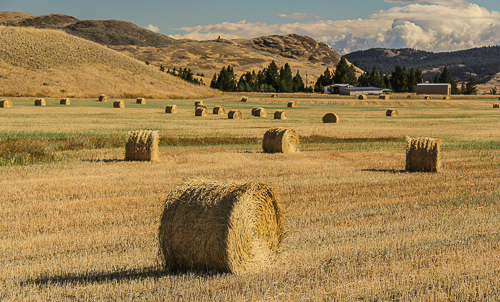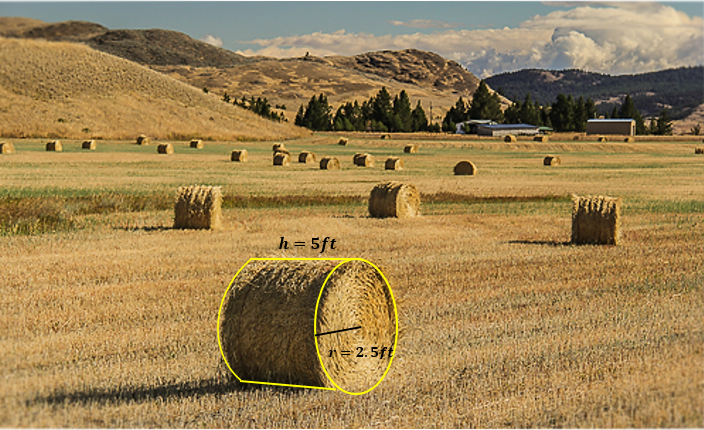The object that should be the main focus in the picture is the roll of hay that is seen in closer to you. This picture is usually seen in a rural area where farmers are creating the hay in the roll of hay. However, some students have have seen bails of hay that are rectangular instead in a cylinder shape. This picture may ignite motivation in students to complete a problem that has to do with agriculture of this type because it deals with a real world situation and they live in an area that have hay farms.
When viewing the picture below, all the students see are rolls of hay in a field of grass.
(Picture was found at: https://rprtphoto.wordpress.com/tag/bale/)
The problem that the students will focus on is finding the volume of one roll of hay given specific measurements where height is 5 ft and the radius is 2.5 ft. View the picture below. The students will need to know the volume of a cylinder in order to do the problem. Moreover, this problem is aligned to the Common Core Standard: CCSS.MATH.CONTENT.HSG.GMD.A.3: Use volume formulas for cylinders, pyramids, cones, and spheres to solve problems.*
In addition, if a teacher wanted to extend the problem of calculating the volume of one roll of hay, the teacher can have the students solve different heights and radius of rolls of hay and solve which size of hay is the better buy for the money. Or the teacher can ask: “How many rolls of hay can fit on a hay trailer that is 6 and half feet in width and 37 and half feet in length?” The students will need to use the width (height) and the diameter in order to see how many can fit on the hay trailer.


Students could also make an equation that could estimate amount bales that correspond the size of the field knowing the volume of the bale.
Potential common core standard:
Create equations that describe numbers or relationships.
CCSS.MATH.CONTENT.HSA.CED.A.1
Create equations and inequalities in one variable and use them to solve problems. Include equations arising from linear and quadratic functions, and simple rational and exponential functions.
I like this problem. It is very applicable over on this side of the state.
Another problem you could do with this picture once the students know the volume of the circular hay bales is to have them calculate how many rectangular hay bales could be created using the same amount of hay.
To do this students would have to know the dimensions of a rectangular bale of hay so that they could then calculate the volume. Then students would have to create an equation that would have the form:
Volume of 1 Circular Hay Bale= (Volume of 1 Rectangular Hay Bale) x (number of Rectangular Hay Bales)
CCSS.MATH.CONTENT.HSA.CED.A.1
Create equations and inequalities in one variable and use them to solve problems. Include equations arising from linear and quadratic functions, and simple rational and exponential functions.
This picture and the problem you made could also fit the following CCSS:
CCSS.MATH.CONTENT.HSG.MG.A.1
Use geometric shapes, their measures, and their properties to describe objects (e.g., modeling a tree trunk or a human torso as a cylinder).
Or using a different standard and a slightly different question this picture could still be really effective. You could ask students to find dimensions of the hay rolls to satisfy certain volume or surface area constraints. This could be rationalized by needing to cover the hay roll or needing the hay roll to take up a certain amount of space to make it worth it to be stored. The question could be as simple as “If you need the rolls to have a volume of X, what should the radius be if the height is Y,” or more complicated like “If the hay rolls get a cover that protects Z square feet, what is the largest radius of the bales if the height is at least W?” This would apply the following CCSS:
CCSS.MATH.CONTENT.HSG.MG.A.3
Apply geometric methods to solve design problems (e.g., designing an object or structure to satisfy physical constraints or minimize cost; working with typographic grid systems based on ratios).
Another question that could be asked using this picture is to find and compare the rates of which a tractor can bale the hay. For instance, if there was a tractor that could bale the hay in the cylindrical bales at a certain rate and also bale the hay into rectangular bales at a different rate, students could decide which method could be more economical.
In this problem, students will have to create equations for each method the tractor uses and compare the different rates. This satisfies the following common core standard:
CCSS.MATH.CONTENT.HSA.CED.A.1.